Depreciation of the Lanka Rupee

Was the 2022 March rapid depreciation of the Sri Lanka Rupee(LKR)
against the US$ unexpected or a result of Foreign exchange policies
adopted by CBSL since 2005 to keep the depreciation at a rate much
lower than the observed trend since 1977?
The historical depreciation of the Sri Lankan rupee since exchange
control was introduced in the 1960s is depicted in this time series
graph. The exchange rate per US$ has been plotted on a logarithmic
scale to clearly illustrate the full range of values from Rs4 in the
1960s to the current Rs360, and the rate of change of depreciation.
The early 1970s was an era of strict exchange control, when you could
get only a few dollars when travelling abroad, various devices like
Foreign Exchange Entitlement Certificates FEECs which effectively
created two different exchange rates. The value of the Rupee was
devalued from Rs8.60 to Rs16.13 on 1977 Nov 16th by the JR Jayawardena
government to open the economy. Over the next 27 years the Rupee
depreciated at an almost constant rate of about 7.6% per year with
respect to the US$. Although it can be seen to deviate from the fitted
line on occasions, it always seems to come back to this trend line
within about a year. When you extend this trend line back it cuts the
value in the early 1960s when exchange control was first
introduced. The 90% depreciation in 1977 appear to be catchup for
about 15 years of strict exchange control,
This trend continued till 2005 when the devastating Tsunami of 2004
December, brought in so much foreign aid that the exchange rate to the
US$ dropped very soon after, from Rs105 to Rs95. Since then over the
next 13 years the Rupee depreciated at a much lower rate of 3.4% per
year. Ajith Nivard Cabraal took over as Governor of the Central Bank
in 2006 July and maintained the lower trend even though Sri Lanka
still had an ongoing civil war with the LTTE. When this war ended in
2009 May, the Rupee appreciated by 5% over the next 2 years. Did CBSL
release more US$ to maintain an exchange rate lower than the natural
trend? The CBSL may have wanted to reduce the amount of rupees that
needs to be paid for the foreign exchange remitted from abroad by the
large number of migrant workers, which was supporting our economy.
With a Rupee depreciating less, Sri Lanka was able to show an apparent
higher rate of increase in the GDP and migrate proudly from a low
income to a middle income country. With a GDP over US$4000 Sri Lanka
lost the ability to get loans at a lower interest. After the
Government changed in 2015 January, many irregularities, such as
hidden foreign debts were exposed and compounded with a Bond Scam the
Financial Rating for Sri Lanka dropped, and the cost of borrowing
money increased. In 2018 the Rupee was depreciated 19% from Rs153 to
Rs183 to the US$, with Indrajit Coomaraswamy as Governor of CBSL. In
2021 July, Basil Rajapakse entered parliament via the national list
and was made Finance Minister. In 2021 September Ajith Nivard Cabraal
resigned as national list member in Parliament and became Governor of
CBSL again.
CBSL maintained a non-credible peg at Rs200 to the US$. In 2022
January they paid back a Sovereign Bond of US$500 million and
interest, despite all economic indicators that CBSL could not afford
to do so. CBSL anyway defaulted on their Sovereign Debt in March. For
many years the Kerb rate had been only a few rupees different from the
official rate, even less than the selling rate of some Banks. From
about 2021 September the Kerb rate started to increase and Undial and
Hawala transfers got well established. The amount of Foreign exchange
remitted
through legal channels decreased to about 35% YoY by 2022 February. By
2022 March the Kerb rate was Rs250. When the exchange rate was floated
on 2022 March 9th, CBSL hoped it would settle at about Rs230. However
it rose rapidly to Rs365 in 2 months when CBSL removed the float and
pegged it around Rs360. The exchange rate had almost caught up, what
it would have been if the previous long term depreciation had
continued from 2005 as shown on the graph.
Both Cabraal and Basil, blamed for the financial crisis, resigned in
early April. CBSL has however confirmed in an RTI, that banknotes
dated 2021-09-15 were printed with their signatures and came into
circulation in 2022 August.
The Aragalaya was not amused.
The rapid depreciation by 80% in two months has created over 100%
inflation in food prices, and a loss of trust in the Sri Lankan
rupee. Assuming that it will precipitate a depreciation like in
Venezuela or Lebanon, it has made those with significant rupee assets,
decide to try to change it to US$ at whatever cost. Therefore the Kerb
rate has remained Rs 30 to 50 above the official rate. Most of this
Foreign exchange never reaches Sri Lanka, as it is accepted in cash
overseas and LKRs are paid in cash directly to the recipient at their
home, avoiding any record in the banking System. Although CBSL has
outlawed it, such exchanges in cash are impossible to track. Over the
last year Sri Lanka has lost over US$4 Billion from Foreign
remittances.
A year later in 2023 March when the IMF loan was just about to be
approved there was a sudden appreciation of the Rupee, as seen on
graph above. All those that had purchased or not converted US$, an
year earlier, when the rupee was rapidly depreciating, started to sell
creating an appreciation of 11% in 1 month stayed steady and dropped
another 9% or a total of 20% before starting to depreciate again.
It is reported the central bank got US$½B which they purchased
with Printing LKRs. What will happen next although uncertain, I
suspect will be a another depreciation later this year when Sri Lanka
starts to repay its foreign debts.
 The natural trend is just an observation that I will leave to the
economists to explain. There are probably many factors that need to be
considered to properly understand its cause and effects. For example
the Indian Exchange rate to the US$ also shows a lower rate of
depreciation after year 2000 and may have influenced the Sri Lanka
depreciation as our trade and economy is strongly dependent on India.
The natural trend is just an observation that I will leave to the
economists to explain. There are probably many factors that need to be
considered to properly understand its cause and effects. For example
the Indian Exchange rate to the US$ also shows a lower rate of
depreciation after year 2000 and may have influenced the Sri Lanka
depreciation as our trade and economy is strongly dependent on India.
The way out of the shortage of US$, by the exchange rate remaining
much lower than the natural trend, has still to be worked out. The
catch 22 situation is that this shortage of foreign currency will not
improve till foreign remittances return to previous levels, and that
will not happen till the Economic combined now with a political crisis
is more stable.
The 2022 August version of this web page was published in the Sunday
Times of Sri Lanka on 2022 August 7th, Page 18
The historical depreciation of the Sri Lankan rupee
and reference by the Editorial
People participation and transparency in public finance
in the same issue.
Daily Exchange rate Data was obtained from
Federal Reserve Bank
and archive of older data on FRB saved at
archive.org
FRB publishes Exchange Rate data of
24 countries
including only India and Sri Lanka from South-Asia.
Section 522 of the amended
Tariff Act(P142-143) of 1930 does not specify the currencies
needed to be certified by the Federal Reserve Bank of New York for
customs purposes. There are 180 currencies in the world circulating
197 countries of the World Today. Inclusion of Sri Lanka among the 24
selected must reflect the former importance of the Ceylon Rupee.
This web page and Graph was originally posted online since around in
1996 and updated daily till 2004 September using my plot program demon
(developed mongo) via an automated crone script on a UNIX server. I
saved that last web page as it was when
I left the USA and retired to Sri Lanka. Being unfamiliar with
MicroSoft eXcel I asked for help from many persons but didn't get a
satisfactory Graph. Finally I spent time trying to do so myself
starting with a version created for me by my research assistant Kasun
Jayasuriya. I convinced myself that excel just does not have the
capability to do so. On a suggestion of Dr Nalin Samarasinghe now
replaced with graph made on 2022 August 9th using gnuplot.
gnuplot was now much improved and more user friendly, since I had
tried it many years ago. This page will now be updated when there
is a significantr change in the exchange rate or weekly if and when
I am able to develop a script using lynx, awk and sed to do it automatically.
Kavan Ratnatunga 2023 October 30th
 The natural trend is just an observation that I will leave to the
economists to explain. There are probably many factors that need to be
considered to properly understand its cause and effects. For example
the Indian Exchange rate to the US$ also shows a lower rate of
depreciation after year 2000 and may have influenced the Sri Lanka
depreciation as our trade and economy is strongly dependent on India.
The natural trend is just an observation that I will leave to the
economists to explain. There are probably many factors that need to be
considered to properly understand its cause and effects. For example
the Indian Exchange rate to the US$ also shows a lower rate of
depreciation after year 2000 and may have influenced the Sri Lanka
depreciation as our trade and economy is strongly dependent on India.
